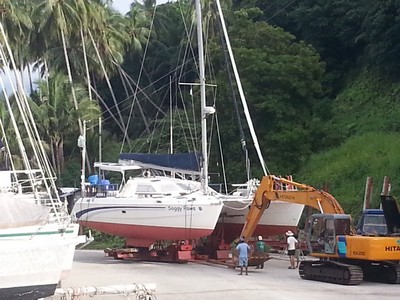
By the way, this was our 4th time clearing in to the Philippines in Davao, and it was an easy thing, and cheaper than before! (They have done away with the "fast track" fee which always seemed like a boondoggle to us. Perhaps because our friend Rob on Changing Spots made an ugly scene when he check in in April and challenged it). The cost at Immigration to clear in with 2 people was only 720 PHP--only $15 USD at today's exchange rates. We noticed some other changes at Immigration--the huge lines waiting for passport processing (visa renewals, etc) seems to have gone down. Either the foreigners have gone home or someone in Immigration has streamlined the process a little. The waiting room was empty by about 10am when we finished clearing in.
OK, back to the haulout. Tata, the yard foreman and primary welder, had assembled a steel cradle custom set-up for our boat. They put the cradle on a lowboy trolley, and back it down the ramp. At high tide, we bring the boat up to the ramp, over top of the trolley. Something was different this time than the last (probably cradle a little shorter)--as we came in on a 1.2m high tide, and still had 6" clearance over the cradle supports. Last time, at 1.2m, we couldn't get on the cradle, and had to pull into a slip and wait for the next day, a higher tide).
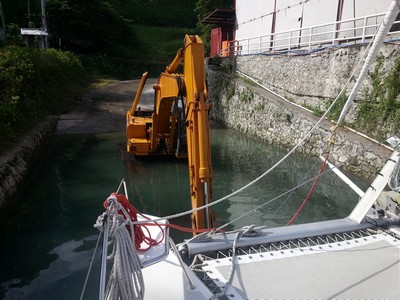
So, for those coming to Oceanview to be hauled--you need a high tide, that occurs during the daytime, that is a little more than the draft of your boat. Hauling out, you want the tide in the morning. Putting back in, it is usually late in the day (sometimes, after sunset is OK, as they put you in, and you just float off as the tide comes up, and get yourself into an available slip).
One challenge we had was that Dave did NOT want to use the port engine. We are still not exactly sure WHAT is leaking, and he didn't want to throw salt water all over the engine if he didn't have to. So we dropped our dinghy in the water and had another cruiser ready to strap to the port side, and be the port engine. However, the dinghy motor starter cord broke right then. So (with high tide fast approaching) we had to scramble to get the marina launch standing by for us at the turn into the ramp area. But it turned out to be an unnecessary precaution, as Dave managed the turn to starboard easily--got going with enough speed in the "fairway" and then eased back on the stbd engine and used our big rudders to make an easy turn. And Tata's guys were there at the cradle to catch us as we came in.
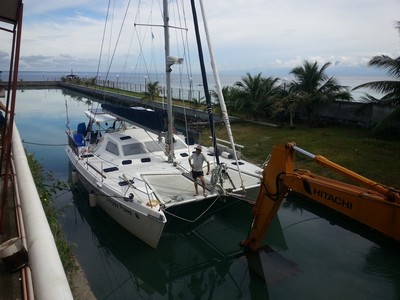
At that point, I loaded my backpack up and took the dinghy to the dock and went up in the clubhouse to work on the computer. Dave stayed to oversee the process.
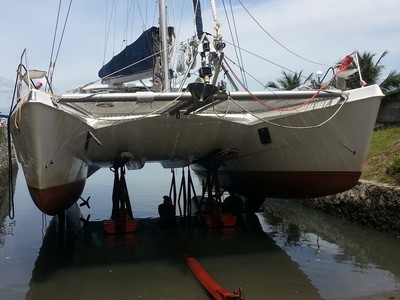
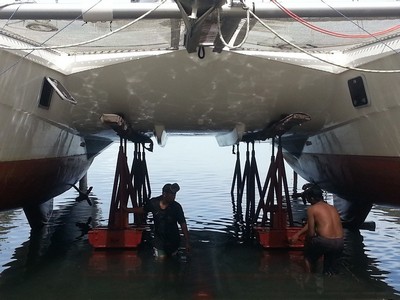
Once the water was down low enough that the boat was fully resting on the cradle, Tata and the guys used heavy lines to tightly strap the boat to the cradle, for the ride up the ramp.
The backhoe backs out of the ramp area, and the cradle is hooked to a large pulley system. The backhoe is positioned at the other end of the pulley system. This puts the backhoe on level ground with good traction, and provides about a 10:1 purchase on the "pull". As the boat creeps up the ramp, two guys are behind the boat with large blocks of wood, making sure that if anything happened, the cradle/trolley wouldn't roll back down the ramp. And 2-3 guys are in front, with levers, helping to move the tongue of the trolley, to steer the trolley part way around the corner. As the trolley approaches the corner turn, the pulleys are re-arranged to pull the trolley the final distance up the slope.
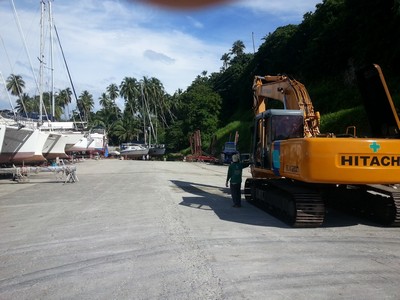
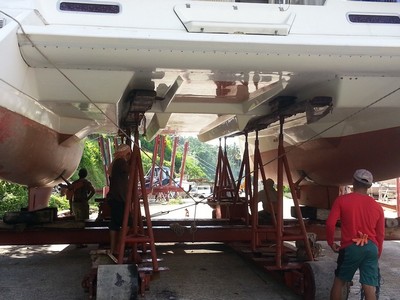
At the top of the slope, everyone pauses for a smile and break. Here if the boat needs a scrub or a pressure wash, the guys do that.
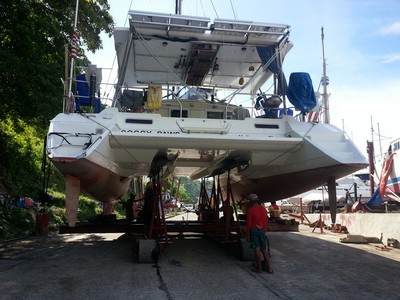
Then when all is ready, the backhoe hitches directly to the trolley again, and maneuvers the boat into position in the yard. Once in position, hydraulic jacks are used to lift the cradle off the trolley, and pull the trolley out.
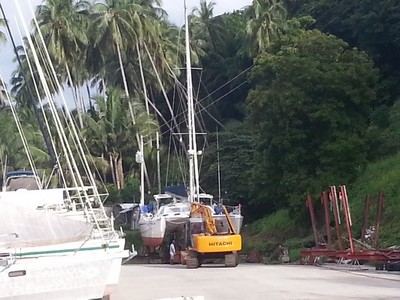

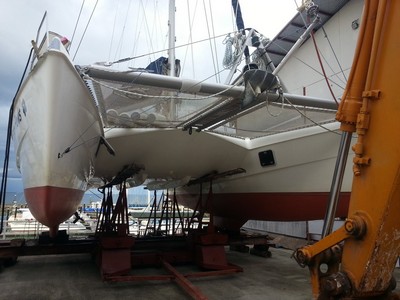
After 3 months of hard work in the yard earlier this year, people are wondering what else needs doing?? Well, truth be told, we spent a lot more time in January through April getting the old Soggy Paws whipped into shape for sale. We did the barest minimum we could do on the new Soggy Paws, in order to get launched in time to make the start of the Indonesia Rally. After a season of cruising, we have a couple of things that required a haulout, and a long list of small things to get done.
The biggest project is replacing the small and highly inefficient "dorm room" refrigerator with a larger, better-insulated, Frigoboat keel cooler unit. We'll have the guys here build a custom box into the port aft bunk. The space where the tiny refer is will be converted into shelving. Plus we'll add shelving in the port aft bunk, converting that space into a nice pantry next to the galley. One of the first things I said when we flew to look at then-Blue Moon was "Where the heck do they store the food for all the people this boat will sleep?". I can't believe the previous owners--a family of 5--actually cruised on this boat for as long as they did.
We are hoping the saildrive leak is just a leaky seal, and that we can get replacement parts easily here. We've got Jonathan, a local expat who works on boats, and is familiar with Yanmar saildrives, lined up to help Dave look at the problem.
We are still trying to decide whether we want to paint the waterline up about 2 inches. I hate to do it, because it means we've given up on taking some of the "stuff" off the boat. But we're at a point where neither Dave nor I are willing to do without the spares and stores we have aboard. We've made a lot of progress sorting and getting rid of stuff since April, but not enough.
your site is a treasure of information. Thanks a lot for the work you've done.
ReplyDeleteI had the same drive leak problem on my Maxim 380 catamaran (SD 20 drive)and replaced the diaphragms on both engines.
Thanks again, Michael "Two Oceans"